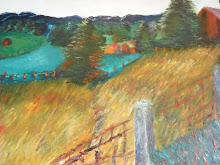We decided to take a walk around the now closed Dan River Mill. The old textile mill was the major employer of the people of Danville, VA for over 100 years. Much of the major infrastructure of the downtown area centered around the mill, like housing for mill workers, personnel offices, etc. When the textile company faced bankruptcy several years ago and subsequently was bought by an Indian chemical company, what to do with the empty mill buildings became a subject of heated debate in the community. Eventually, it was agreed to tear down the buildings and salvage as much material as possible to be used in other projects around the country.
We took a walk near the Schoolfield Mill section on Saturday, and I couldn't help but notice that throughout the various ruined structures, there were little glimpses of nature reclaiming the space.
 This is the worker's parking lot across from the entrance to the mill. Besides the warping of the asphalt, the growth of grasses and weeds through the cracks is fairly impressive.
This is the worker's parking lot across from the entrance to the mill. Besides the warping of the asphalt, the growth of grasses and weeds through the cracks is fairly impressive. I love how the massive pine trees mirror the spacing of the old smokestacks.
I love how the massive pine trees mirror the spacing of the old smokestacks. This is the turnstile that workers went through every day to get to work. It also reminded me of pine tree branches.
This is the turnstile that workers went through every day to get to work. It also reminded me of pine tree branches.This little tree was growing underneath the mill's electrical substation. It clearly has grown up since the mill closed, which is pretty remarkable considering it never would have been there if the substation still directed power to all of the mill buildings.
 I was struck by the almost bovine colors of this rusting structure (housing for heating/cooling? I'm not an engineer, obviously):
I was struck by the almost bovine colors of this rusting structure (housing for heating/cooling? I'm not an engineer, obviously): See the holes worn into the rusted sections? I made up a little story to myself about how they were broken down by birds who now use them for shelters, but that is probably my overactive imagination again. Speaking of nests:
See the holes worn into the rusted sections? I made up a little story to myself about how they were broken down by birds who now use them for shelters, but that is probably my overactive imagination again. Speaking of nests:
There were nests EVERYWHERE! I was so surprised--it's as if the people moved out and the birds moved in. I loved the way the seed pods (whirly-gigs) decorated this tree. I took some home with me to see if I can grow my own whirly-gig tree in Oklahoma.
 If you look closely, you can see that this pile of bricks and structural elements (which has been there for about a year) is covered in grass. Yes, grass has literally grown up over the wreckage. Will this pile ever be moved, or will future civilizations find it after they excavate the area?
If you look closely, you can see that this pile of bricks and structural elements (which has been there for about a year) is covered in grass. Yes, grass has literally grown up over the wreckage. Will this pile ever be moved, or will future civilizations find it after they excavate the area?It should be said that we obviously were not able to walk throughout the site. There was a tall fence that kept me walking and positioning myself to try to come up with interesting photo angles (and, alas, hindering my efforts in most cases). I was interested in the way the fence played a role in the following two photos.
 It looks as if this felled tree bough was trying to escape the mill, with half on either side of the fence. And this is my favorite:
It looks as if this felled tree bough was trying to escape the mill, with half on either side of the fence. And this is my favorite: This gorgeous little vine was growing (and blooming) along the outer fence. I could say something about hope or opening windows accompanying closed doors here, but I'll let you come to your own conclusions.
This gorgeous little vine was growing (and blooming) along the outer fence. I could say something about hope or opening windows accompanying closed doors here, but I'll let you come to your own conclusions.On a personal note, I snapped this picture of three generations of Cook/Thorntons (Joe, Dad & MaWat) huddled outside of the mill that sustained recent ancestors:
 In a few years the rest of the mill will be torn down and our son will be grown up. Of course, I can't help but wonder what he'll find if he ever decides to return to this site.
In a few years the rest of the mill will be torn down and our son will be grown up. Of course, I can't help but wonder what he'll find if he ever decides to return to this site.




No comments:
Post a Comment